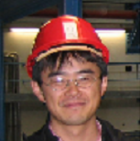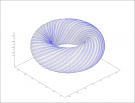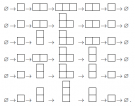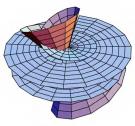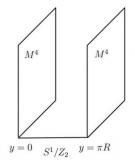The currnet study: high energy physics experiment using particle accelerators
High energy physics (elementary particle physics) is a study to elucidate the minimum element (elementary particle) that forms a substance and the force (interaction) that acts between them.
There are theories and experiments in physics research, and the latter needs to "see" the minimum element.
"To see an object" is to hit another object as probe against the target object and investigate recoil of the probe or products of the collision.
For example, we can see an object with an optical microscope collecting visible light scattered by the object. In order to see elementary particles, we use high energy particles instead of visible light. According to quantum mechanics, high energy is necessary to see small objects. A "microscope" for seeing elementary particles is a particle accelerator , which accelerates charged particles (such as electrons, protons and their antiparticles) to high energies with high electric field and makes these particles collide head-on with each other. By looking at various particles generated by collision in detail, you can investigate the world of elementary particles. This is why it is called "high energy" physics. Since the generated particle by collisions can ionize atoms in material, a dedicated radiation detector as an "eye" is necessary.
The minimum elements of the substances currently being confirmed are six kinds of quarks and leptons. Protons and neutrons are made up of three quarks. Electrons are members of leptons. There are four kinds of forces working between these elementary particles: electromagnetic force, gravity, strong force to bind protons and neutrons to form nuclei, and weak force to decay the radioactive isotope. The last two work only in the world of elementary particles. Conversely, gravity is extremely weak in the elementary particle world compared to the other three forces and can be ignored. Three forces working in the world of elementary particles are also transmitted by elementary particles called gauge particles. Furthermore, there are Higgs particles which are the origin of mass of elementary particles. The framework of the theory explaining these elementary particles collectively is called "standard model"(SM) of elementary particle physics. Since the 1970's, a number of experiments have been conducted to verify SM. Surprisingly, SM consistently explained all the experimental results, and deviations from the theory have not been found out. The last missing piece, Higgs boson was finally found in 2012, SM was a great success.
However, although it is a standardized theory with great success, there are several complaints. It is impossible to predict with SM that there are many parameters, therefore it must be decided from experimental results. Also, SM can not explain why there are four forces, what dark matter in the universe is. In order to solve these problems, theorists have proposed theories beyond SM as an extension to SM , for example, minimum supersymmetric SM).
Study of the world of elementary particles by the world's largest accelerator
LHC / ATLAS experiment
One of approaches of experimental studies in high energy physics is to use an accelerator. The approach is to achieve a collision energy as high as possible so as to make it possible to generate heavier particles and new phenomena. A representative example is the large hadron collider (LHC) of the European Laboratory for Particle Physics (CERN) located in the suburbs of Geneva. It is installed in a circular tunnel with a circumference of 27 km and a depth of about 100 m underground and makes protons collide with protons accelerated to 7 trillion electron volt in the opposite direction. The experiment began in 2008.
One of detectors that "see" phenomena when protons collide with each other by LHC is the ATLAS experiment. I participated from the planning stage, and for more than 20 years I have been designing some measuring instruments, I am involved in the construction, the operation of the detector. The ATLAS detector is a huge measuring apparatus with a cylindrical shape with a diameter of 23 m and a length of 44 m. The figure below is a picture of the ATLAS detector.
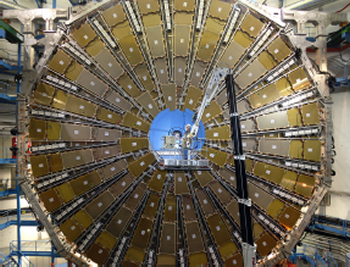
Detector attached to the ATLAS detector. The size of one brown detector is about 1 x 2 mm^2 (one provided by CERN)
Higgs particle had to be found in the LHC / ATLAS experiment in order to prevent SM from failing. Higgs particle finally was discovered in 2012. Discovery of Higgs particle by the ATLAS experiment is stated in Dr. F. Englert and Dr. P. Higgs' Nobel Prize for Physics in 2013. The ATLAS experiment further goes ahead, more precise verification of SM through measurement of the properties of Higgs' particle etc, phenomena predicted by theories beyond SM, such as supersymmetric particle search and black hole generation. The new knowledge gained from this experiment will make elementary particle physics go beyond the framework of SM and advance to a new stage.
Development studies of radiation detectors
"Eye" necessary for high energy physics experiment is a custom made radiation detector. It is one of our roles to develop a detector with good performance. Radiation detectors are applied to a wide range of fields including radiation diagnosis and treatment in the field of therapy. I am especially developing radiation measurement equipment using gas. We are aiming to develop a detection device that uses fine structure processing technology and has good performance and easy handling.
Message to everyone for high school students
It seems that the search for the minimum building blocks of our universe continues after the ancient Greek era and is intrinsic nature of human beings. Its cutting edge research is high energy physics. High energy physics experiments in recent years remains in a state of verification of SM, "the quietness before the storm" state. As LHC went into operation, Higgs boson we were seeking was discovered and SM was very successful. The deiscovery is a trigger to open the door of a new era beyond SM. I think it is very fortunate that we can be a part of such a revolution moment of high energy physics. Everyone please look forward to the world image of new elementary particles. I would like you to explore unknown areas with us.
